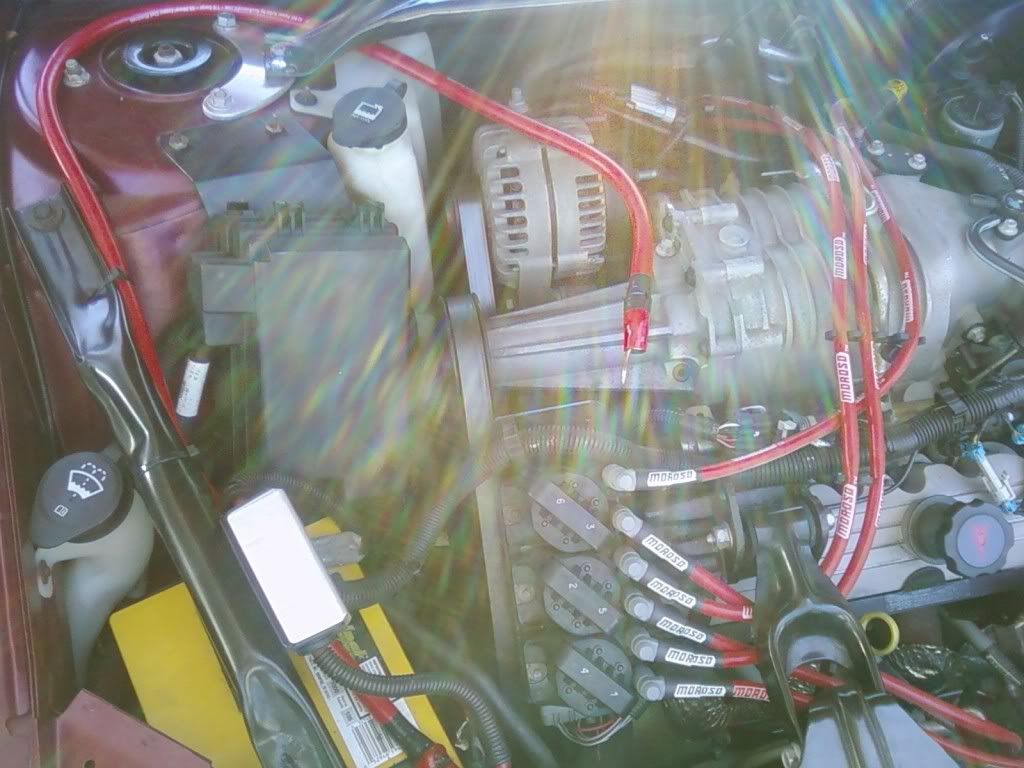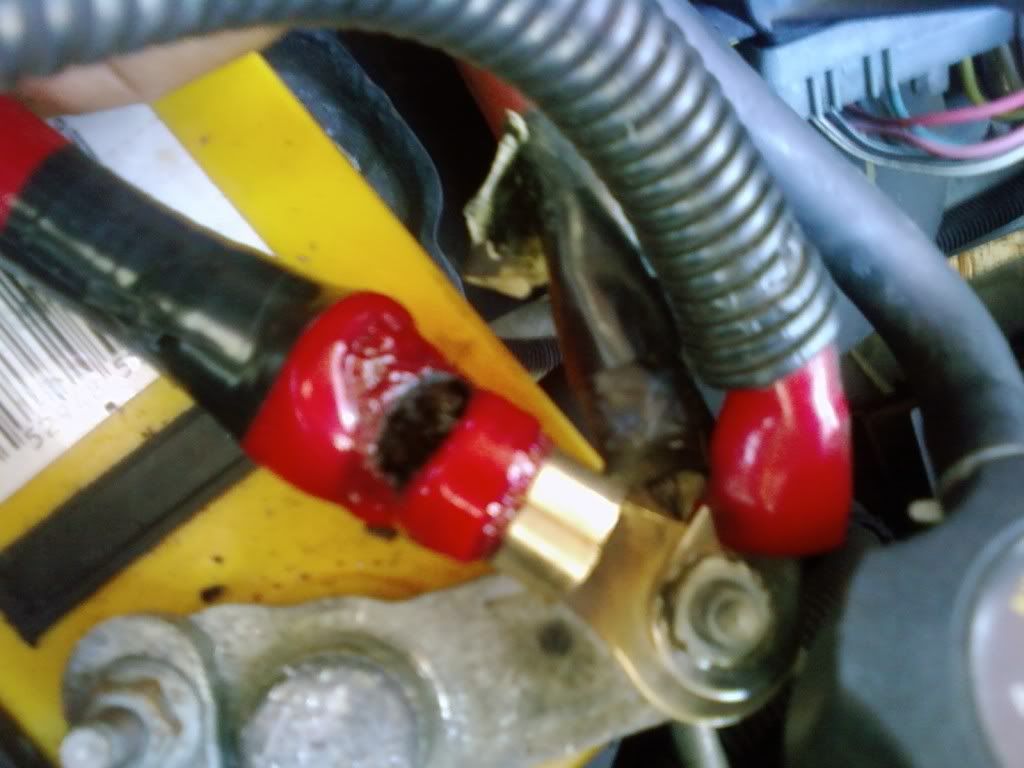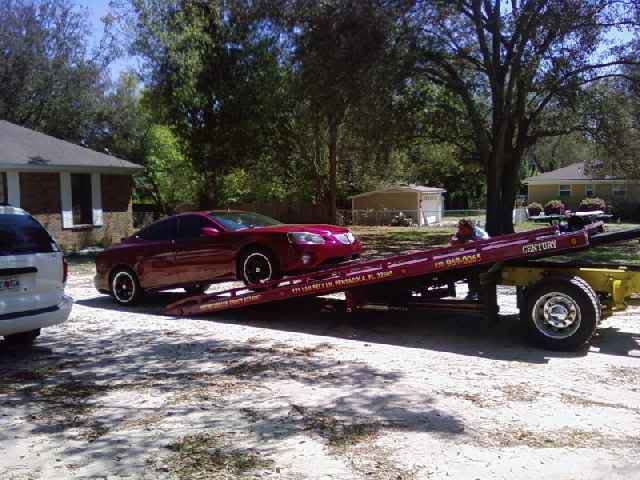Today I spent my morning trying to help my friend get his car started. Its an 04 Gran Prix GTP, very nice. Anywho open up the hood and there's this huge ass red wire (0 gauge) running from the positive post to a bolt on the alternator. There's a plug that caps on the bolt on the alternator like how sparkplug wires have. Anyway, the side of the cable that was attached to the battery COMPLETELY fried itself, melted off. Car wouldn't start or anything just click. I figured it was the battery. Computer went haywire, no stability control, abs, tc, nothing. Well we spent the morning taking off the aftermarket add-ons and eventually sent it to one of the pontiac/gmc/buick dealerships. Fixed it, they said it was the alternator, battery was fine. When I say it was dead it was dead. Nothing electronic would work lol. On his pontiac forum they recommended it because has to amps (1 for subs and 1 for doors/deck) and he had a voltage amplifier too. Here's the pics. Sorry for quality, took them from my LG phone. BTW he had his system since had the car, but he added this 0 gauge red wire and boom kills the car.
<div align="center">
![Image]()
Looking at the left side of the picture there's the battery and the red 0 guage wire running up and around the strut. I unplugged it from the alternator. If you look closely on the right side of the alternator there's a long bolt. That's where it was connected to. He had his wires for the subs ran professionally. This 0 gauge wire was added by himself last week. The little silver box is the fuse for the system.
![Image]()
The side that was connected to the battery. It's still technically connected but it melted all the way through. Ashes were piled up around that area. It just fell apart easily.
![Image]()
TOW TRUCK ARRIVES!
![Image]()
NOOOOOO!!!!
![Image]()
IM READY, IM READY, IM READY!
It's a VERY nice car. He's not into chrome so he got some black 5-spoke tsw jarama wheels. (w00t) This is my favorite Grand Prix. Now my question(s) is/are: How dangerous was this exactly? At first I thought something was fried and checked the fuses. Only one that was blowed was the power wire that ran to the subs (silver box). Other members have it done and there's are fine, but his like short-circuited. The cause we the voltage amp? IDK. Not an electrical genius. Milly00, Xedos, Yel-low? And what is the point of doing this?
Welp, thats how I spend my morning, tinkering on a nice car, and taking out HIDs and other misc stuff to get it ready for the dealership (warranty). :angel:
OH BTW, did you know his whole freaking gauge cluster comes out! The tach/speedo and everything is WHOLE. It's plug and play! He has a GXP one that he had to swap out for his stock one. You just take off some interior pieces and unscrew some screws an WAH-POW! the bitch just comes out like whole. It's like pluggin in a ipod to the comp. :rofl:
EDIT: I haven't a clue on hooking up/wiring stereos, never changed a head-unit etc. Feel like I'll shock myself or blow up the milly. Believe me I can do it and not even mean too. :x That's probably why its stock still. My friends hook up their own stuff. Usually they'll get the wires ran professionally and finish up the installation. They're very good with the electical stuff, but still the 0 gauge wire stumps me. It was recommended so he tried it. Epic Fail. :stretcher:
<div align="center">

Looking at the left side of the picture there's the battery and the red 0 guage wire running up and around the strut. I unplugged it from the alternator. If you look closely on the right side of the alternator there's a long bolt. That's where it was connected to. He had his wires for the subs ran professionally. This 0 gauge wire was added by himself last week. The little silver box is the fuse for the system.

The side that was connected to the battery. It's still technically connected but it melted all the way through. Ashes were piled up around that area. It just fell apart easily.

TOW TRUCK ARRIVES!

NOOOOOO!!!!

IM READY, IM READY, IM READY!
It's a VERY nice car. He's not into chrome so he got some black 5-spoke tsw jarama wheels. (w00t) This is my favorite Grand Prix. Now my question(s) is/are: How dangerous was this exactly? At first I thought something was fried and checked the fuses. Only one that was blowed was the power wire that ran to the subs (silver box). Other members have it done and there's are fine, but his like short-circuited. The cause we the voltage amp? IDK. Not an electrical genius. Milly00, Xedos, Yel-low? And what is the point of doing this?
Welp, thats how I spend my morning, tinkering on a nice car, and taking out HIDs and other misc stuff to get it ready for the dealership (warranty). :angel:
OH BTW, did you know his whole freaking gauge cluster comes out! The tach/speedo and everything is WHOLE. It's plug and play! He has a GXP one that he had to swap out for his stock one. You just take off some interior pieces and unscrew some screws an WAH-POW! the bitch just comes out like whole. It's like pluggin in a ipod to the comp. :rofl:
EDIT: I haven't a clue on hooking up/wiring stereos, never changed a head-unit etc. Feel like I'll shock myself or blow up the milly. Believe me I can do it and not even mean too. :x That's probably why its stock still. My friends hook up their own stuff. Usually they'll get the wires ran professionally and finish up the installation. They're very good with the electical stuff, but still the 0 gauge wire stumps me. It was recommended so he tried it. Epic Fail. :stretcher:




